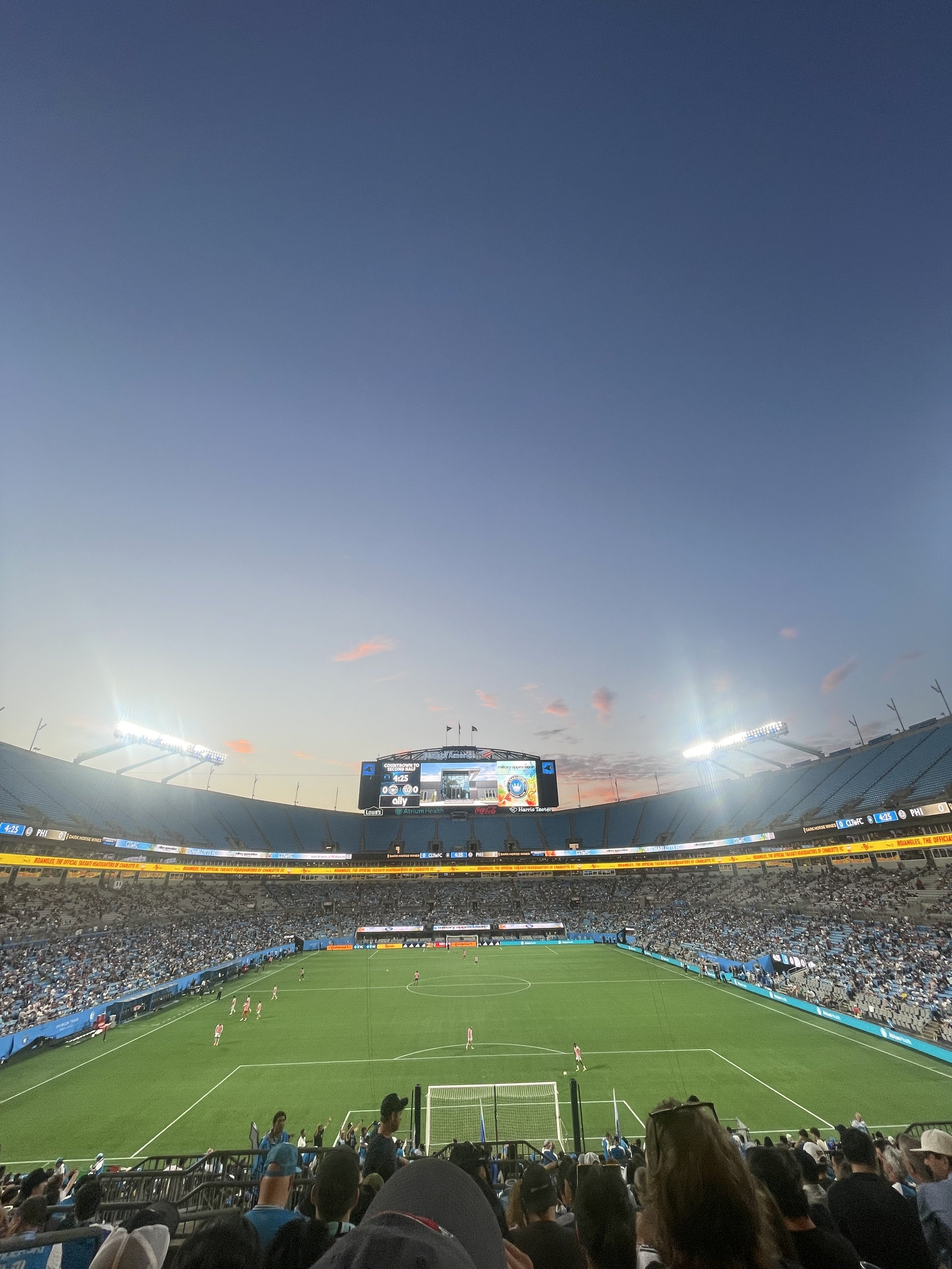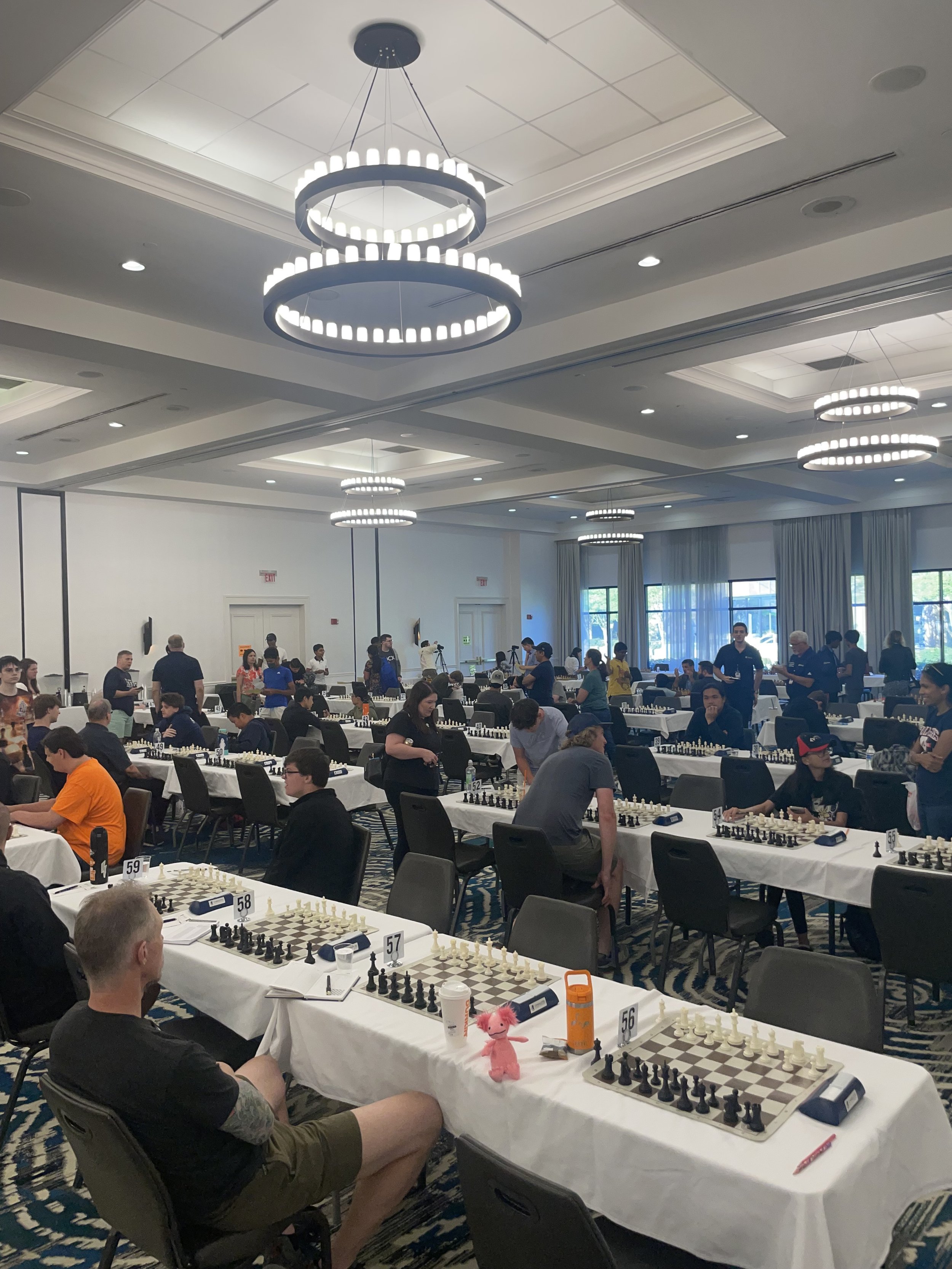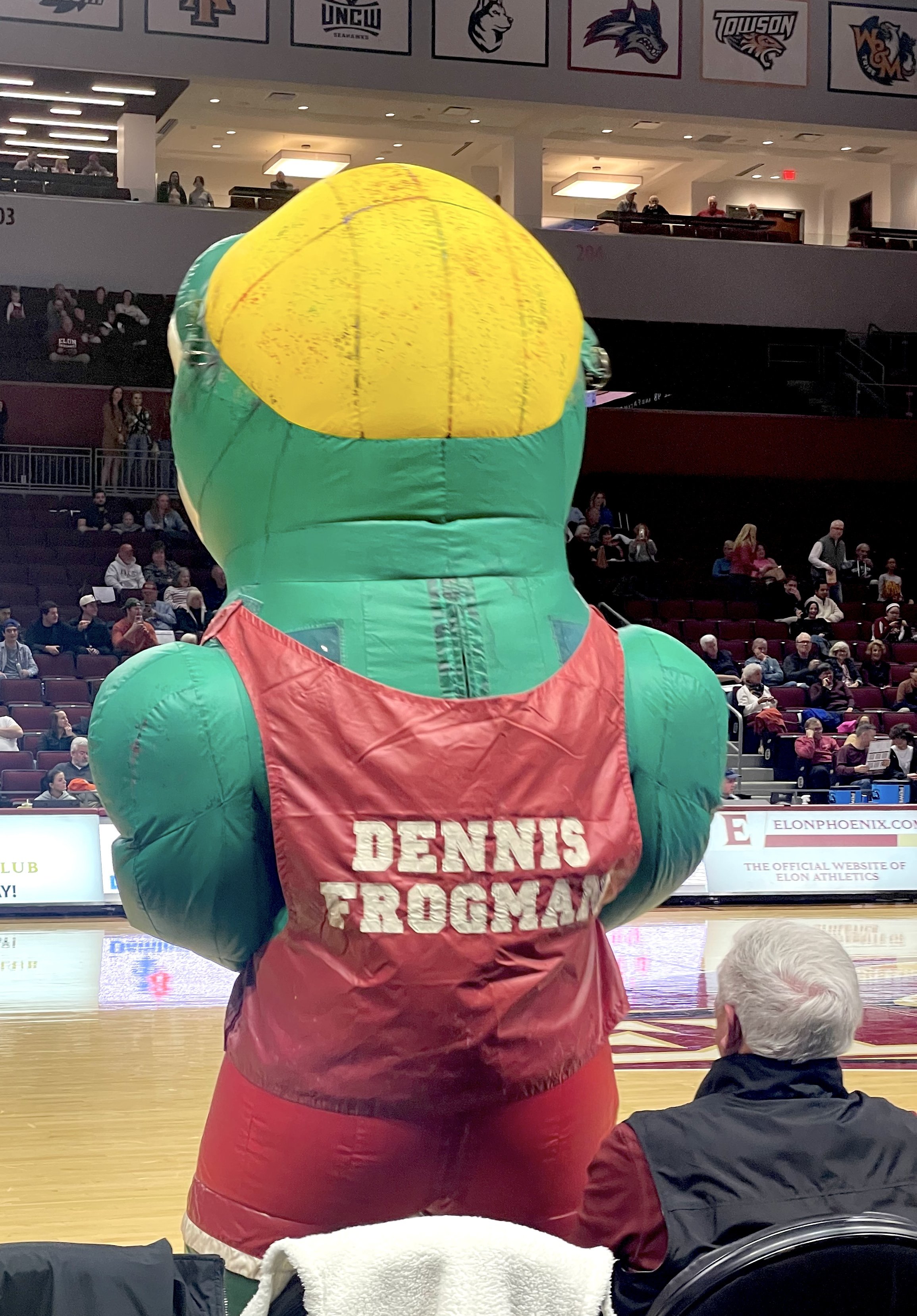American impressions: the sport
Reflections on my time as a Fulbright Visiting Scholar at Elon University, North Carolina.
1. Elon University · 2. Flora and fauna · 3. Teaching technology ethics · 4. The sport · Coming soon: 5. Fulbright · 6. Life in the North Carolina Piedmont · 7. Future of the nation.
I have an advantage in that I already understand and enjoy American sports. It was even part of my cultural-exchange patter in the interview: I’ll buy the foam finger, shout ‘de-fense’, etc.
It’s obvious within the first few games of the season that the Panthers will be done long before I land in January. Bluntly, the Panthers stink the joint out right now, stumbling to a 2–15 record while giving away the draft pick that would have given them a leg up for 2025. Still, having been stateless for a while I at least have an NFL team to follow. The only way is up.
I still make it to the Bank of America Stadium to watch Charlotte FC, a recent Major League Soccer addition. Competent and well-drilled, they’ve smartly tried to capture the sporting attention and energy of the local Hispanic community in particular. Attendances are decent, probably north of 20,000, and the vibes are vibey albeit centrally planned: military flybys, anthem fireworks, loudhailered capos inciting exuberance. There’s none of British football’s spontaneity or in-joke humour yet. The crowd is still learning the game, getting excited by the wrong things and overlooking moments of quiet brilliance, but the game is gathering pace in the US – and don’t forget they’re hosting (most of) a World Cup in 2026.
Ice hockey is the only sport with a great North Carolinian team, and the Carolina Hurricanes become a new love. Since tedious blackout rules wipe Canes games from mainstream cable, I stump up outrageous streaming fees. Their play is fast and skilful, devoid of other teams’ thuggery, although this being hockey there’s still the occasional double-take-inducing fight – why are the referees not intervening? surely this is a shameful nadir for the sport? – before you remember violence is integral to this odd game. Tickets are usually sold out but I score a back-row resale against the Bruins, an uncharacteristic loss. I learn the only American accent I can do well is the fruity overenunciation of hockey announcers: ‘GOOOoooal for the Hurricanes, scored by number 37, Andrei… SVECHnikooov!’ (I make the mistake of telling my students, who immediately demand a performance.) The Canes’ rampant form sees us favourites for the Stanley Cup but we fall at the first stiff playoff hurdle, the New York Rangers. I hear this is common practice – but again, a team for life. All in.
Chess isn’t a sport, much as it wishes it were, but Charlotte has seen heavy investment and hosts three major tournaments while I’m in-state. I play them all, starting well and ending badly. Entry fees are scandalous compared to London but I’ll admit 4-star hotel ballrooms are a big step up from wintry church halls. I pay no mind to my slumping US Chess Federation rating: my unaffected English rating is all I care about, and a terrific win against a 1702 junior keeps my spirits up. I also hang out with delightful chess Twitter folks with whom I share philosophical, musical, and/or analytical interests but who tend to stay on this side of the Atlantic.
You can’t move for college basketball in March, so I end up getting into it. Elon games are fun even though the team’s mid at best. I drink faculty-discounted tallboys in a second-row seat amid sneaker squeaks and jolt-inducing buzzers. Elon’s star player leaves in search of better options once the season ends.
But ever since bootleggers decided to race their souped-up law-evaders it’s been NASCAR that really owns the southeastern US. The Coca-Cola 600 at the Charlotte Motor Speedway is the strangest day of my US stay.
This is MAGA turf. RV campers in the infield erect Trump flags, and in the stands it’s a veritable supermajority of red caps and sloganed t-shirts. There’s something fascinating about the graphic design signifiers of the American right. Not just stars and stripes and eagles – although there are plenty, of course – but also the hunting aesthetic, which itself is a domesticated military aesthetic. Realtree® camo is particularly prized. Fonts are industrial and ultra-heavy: think Impact, chunky extrusions, the type of memes. Occasionally the Roman square capitals beloved of trad Twitter accounts that valorise the ‘lost era’ of European supremacy. The overall look is dense, complex, and entirely masculine. Not so much inelegant as anti-elegant.
I must give NASCAR some credit. They are – I think quite skilfully – trying to defang their audience’s more objectionable material but still leave space for regional pride and self-expression. Confederate flags are banned, a post-Floyd gesture, and stewards eventually negotiate the removal of all overtly political signage. A huge spray-painted TRUMP banner at Turn 1 is gone when I return from the bathroom. Nevertheless, it’s obvious I am not of this crowd. I don’t feel threatened or unwelcome so much as acutely misplaced; I make friends by offering spare earplugs to the unprepared but we don’t exactly discuss the ills of the world. Then Trump Force One flies low over the circuit and the man himself turns up. Mercifully there’s no lap of honour, but the occasional big-screen wave sends the crowd into frenzied approval. After a Memorial Day parade of Black Hawk helicopters and much talk of those who made the ultimate sacrifice – a phrase also heavy with symbolism – the cars finally come out.
Having watched NASCAR on TV now I’ve warmed to the style of racing, strategic, sinusoidal, more about momentum than perfection. But I hadn’t prepared myself for the physical experience. As 128,000 pounds = 58.1 metric tonnes of metal pass in a thunderous peloton, some atavistic awe-fear mixture awakens in me. Like staring into a live tiger’s eyes at a truck stop café – true story, different trip – I feel it inside my heart, and I’m slightly ashamed how impressed I am by brutal, ear-splitting technology.
On lap 249 of 400, with Christopher Bell in the lead, it chucks it down. Oval racing and rain don’t mix, so the event is suspended and most of the crowd recognises the fat lady has sung. Cue transport chaos. Despite a sellout crowd of 95,000, CMS has no allocated spot for pickups so we fight our way to surge-price Ubers caught in eight-lane gridlock. Walking is out of the question. After four cancellations I finally split what turns out to be an hourlong three-mile ride that costs fully $77, our Eritrean driver quizzing me about Newcastle United, where a cousin is setting the Premier League alight.
And we’re not done yet because the next day I actually go in one of the cars for a possibly-health-insurance-invalidating NASCAR Track Experience. I even get three free laps because my driver runs out of gas, coasting expertly back to the refueller. What surprises me isn’t the straight-line speed but the adhesion on the banking, like how does this thing possibly stay on the track? They’ve wisely put padding on the inside of the cockpit to catch your g-forced triceps. It gets slightly hard to breathe at one point. Stupefying.
My dear friend Simon visits for a bucket-list golf trip. It’s still early season and the Bermuda grass is still asleep, giving the grounds a bile-yellow tinge. But the courses are superb. Duke University Golf Club (yes, Duke owns one of the state’s top courses – of course it does, it’s Duke) is wet and hilly, its sweeping fairways lined with pines and its bunkers a death sentence. Tobacco Road is the work of a madman, a cocktail of LSD, Deliverance, and crazy golf. The clubhouse has the whole Southern porch rocking-chair thing going on, which said clubhouse feels more like a BBQ shack than the jackets-required-beyond-this-point crap of England’s elite. We drive home overstimulated. Tot Hill Farm, by the same designer, is similarly unhinged, crammed with rocks and streams, blind shots and cow skulls.
Pinehurst sits at the bougier end of the market. Our veteran receptionist reveals we’re staying opposite Arnold Palmer’s favourite room. She and he were on close – you sense near-intimate – terms when he was a regular. We start with course #8, fiendish and magnificent, before the jewel of the crown, Pinehurst #2. #2 is also savagely tough, as Rory McIlroy finds out in June, but we get out of jail with the weather, dodging a 32mm precip. forecast with just a brief shower. Our caddie Kevin is a wide-grinned Southern charmer – ‘Well now let’s see what we got for ya, Mister Cennydd’ – and helps reduce my score from embarrassing to just real bad. But when it briefly goes well, I can report that sticking an elevated green from 152 yards and being handed a putter is feeling worth chasing. Our final course at Pinehurst, #4, is an affront to my physical and mental wellbeing. Winds reach four-club strength near the end. Facefuls of sand. Simon plays great, I shoot well into three figures. No matter.
Southern Pines is our last stop, overseeded with rye grass and therefore lush and green even in March. Another stunning course, not overlong, with plenty of elevation and wild rolling greens. Later, I pop to Quail Hollow to watch the Wells Fargo Championship. A younger, drunker crowd than British events. The ‘get in the hole’ guys are exactly who you’d expect: sunburned bros stumbling from hole to hole after too many Michelobs. I have a blast despite them and might return for the PGA Championship next year.
In my local bar, I chat with a somewhat overbearing boomer. We talk sport to avoid talking politics. America, he says, could be the greatest at any sport going if it chose to. Then do it, I reply. Put up or shut up. The All Blacks might have something to say about rugby though – and good luck unseating the Chinese at table tennis. Four weeks later, the US beat Pakistan in the T20 World Cup and for the first time my North Carolina bar buddies want to talk cricket.
Fucker may have a point.




















